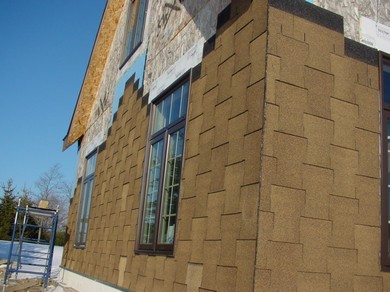Choosing exterior wall siding isn’t as easy as it seems. I was first faced with a choice like this more than 15 years ago, and I opted for something unusual that’s worked perfectly ever since. Funny thing is, this ‘siding‘ isn’t even designed for walls at all.
 A few manufacturers make interlocking asphalt roof shingles and they offer all the benefits of an informal, DIY-friendly siding choice. The last bunch I put up were made by Emco BP, sold under the name Tite-Lok. They cost about 60 cents a square foot, they go up easily and they’re great in situations where low-cost options like vinyl look too suburban.
A few manufacturers make interlocking asphalt roof shingles and they offer all the benefits of an informal, DIY-friendly siding choice. The last bunch I put up were made by Emco BP, sold under the name Tite-Lok. They cost about 60 cents a square foot, they go up easily and they’re great in situations where low-cost options like vinyl look too suburban.
Interlocking shingles are made of the same organic asphalt composition used to make traditional 3-tab shingles. The difference is the way one course is secured to the next. Instead of small strips of factory-applied tar that glue one course of conventional shingles to those below when heated by the sun, interlocking shingles come together with a series of matching slots and tabs. This tar-free, mechanical connection is important for wall siding because regular shingles don’t always work properly when installed vertically. Without gravity pulling one course down over the next, the tar often fails to bond properly. The result is shingles that flop around in the wind and break off. This is why it’s risky to use regular roof shingles on walls. It’s also unnecessary.
Interlocking shingles solve this problem, though there’s something you need to know. Since they come together mechanically, you need to pay more than the usual amount of attention to keep rows of shingles going up straight. If they start to veer off course horizontally, the error compounds as more shingles go up. An easy way to avoid trouble is with a 6-inch level tucked in your tool pouch. Use it to check and adjust the orientation of every fourth or fifth interlocking shingle you put up. I learned about this small precaution the hard way, as my first few courses of shingles began to go off kilter. Use the level and you’ll never have trouble.
 The main reason I installed my first batch of interlocking wall shingles was to create attractive, long-term weather protection on a building that I was covering in a 9-inch thick layer of limestone. Working alone, and quarrying stone entirely from the forest by hand takes forever. The shingles bought me the time I needed, while allowing the stone to go right over top. Since that original experiment in the late 1980s, I’ve seen interlocking shingles used as permanent siding on a few large and small country projects with great success.
The main reason I installed my first batch of interlocking wall shingles was to create attractive, long-term weather protection on a building that I was covering in a 9-inch thick layer of limestone. Working alone, and quarrying stone entirely from the forest by hand takes forever. The shingles bought me the time I needed, while allowing the stone to go right over top. Since that original experiment in the late 1980s, I’ve seen interlocking shingles used as permanent siding on a few large and small country projects with great success.
Although Tite-Lok shingles are available everywhere, chances are that your average building supply clerk won’t be familiar with them. They’re not a popular item, so they don’t sell very often. Just don’t take ‘I don’t know what you’re talking about’ for an answer. Clip this story to show what you want. You’ll also find interlocking shingles online at emcobp.com under the ‘product’ category at the top of the page.
I’m the first to admit that interlocking shingles don’t look right in every situation, but what building option does? If your summer construction plans involve putting up an informal cottage, a backyard shed or a cozy forest cabin somewhere, don’t simply transplant urban siding choices without thinking about it. Interlocking shingles are simple, attractive in a down-home kind of way. The kids can even bounce a tennis ball off them at the cottage without fear of damage. What other siding offers all these advantages and low cost, too?


